Floral nectar is normally a clear liquid and an important source of food for animal pollinators. However, so far nearly 70 plants have been documented to have unusual colored nectar, which is caused by pigmented secondary metabolites but their precise chemistry is poorly investigated and their ecological functions largely unconfirmed.
Leucosceptrum canum Smith, a large tree belonging to the family Labiatae (= Lamiaceae), has an unusual dark brown nectar, and is the only colored nectar plant so far discovered in the Labiatae family.It is a favorite species of birds, attracting over 40 kinds of birds for feeding. For this reason, L. canum is also called "bird’s Coca cola tree” by ornithologists. The Phytochemical Ecology Group in Kunming Institute of Botany, CAS, headed by Prof. Dr. LI Shenghong, previously showed that the glandular trichomes of L. canum harbor a class of unique defensive sesterterpenoids (Angew. Chem. Int. Ed., 2010, 49: 4471-4475), and similar defensive compounds are also present in leaves and flowers of the plant (Org. Lett., 2011, 13: 1864-1867).
Very recently, the research group found that the major pigment responsible for the dark brown nectar of the L. canum is a unique symmetric proline-quinone conjugate, 2,5-di-(N-(-)-prolyl)-para-benzoquinone (DPBQ), based on large-scale collection of nectar (645 ml, from approximately six millions of individual flowers), sophisticated purification, comprehensive spectroscopic analysis including 1D and 2D NMR and HRMS, and chemical synthesis of (-)-DPBQ and (+)-DPBQ and CD analysis. Behavioral experiments of the authentic natural DPBQ, the synthetic (-)-DPBQ and (+)-DPBQ, nectar and nectar sugars on a bird pollinator, Japanese White-eye (Zosterops japonicus), demonstrated that DPBQ functions mainly as a color attractant to bird-pollinators of L. canum. DPBQ represents a novel type of natural pigment in floral nectar, and this is the first time that both the elusive chemistry and ecological function of pigment in colored nectar have been unambiguously disclosed, which should shed more light on the evolution and ecological significance of this enigmatic floral trait.
This work has been published online in Organic Letters (2012, Article ASAP, DOI: 10.1021/ol3017879. http://pubs.acs.org/doi/full/10.1021/ol3017879 ), and was highly evaluated by reviewers. One reviewer said “This paper is a valuable contribution to natural products chemistry/chemical ecology” and “Overall, this is an interesting paper demonstrating how studies of chemical ecology should be pursued by organic chemists”. Another reviewer believed “it’s a textbook example of how this sort of study should be conducted”.
This research was supported financially by the “Hundred Talents Program” of the Chinese Academy of Sciences, the National Natural Science Foundation of China, the National Basic Research Program of China (973 Program) on Biological Control of Key Crop Pathogenic Nematodes, and the State Key Laboratory of Phytochemistry and Plant Resources in West China.
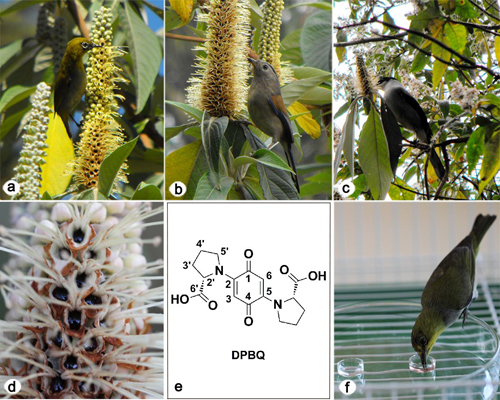
Figure 1. Leucosceptrum canum and its flower visitors. (a) Japanese White-eye (Zosterops japonicus); (b) Alcippe ruficapilla; (c) Heterophasia melanoleuca; (d) Dark brown nectar of L. canum; (e) Chemical structure of 2,5-Di-(N-prolyl)-para-benzoquinone (DPBQ); (f) Japanese White-eye probes DPBQ (500 μg/mL) in the behavioral experiments.
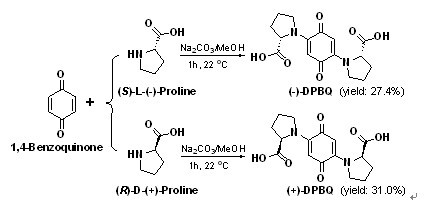
Figure 2. Synthetic routes of (-)-DPBQ and (+)-DPBQ.
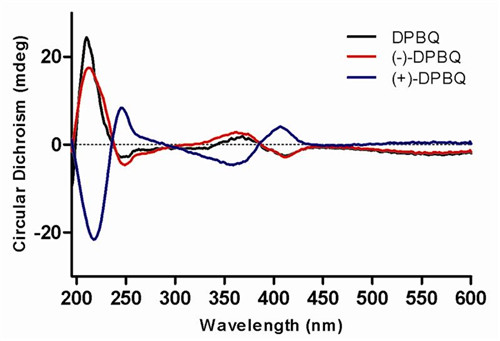
Figure 3. CD spectra of DPBQ, (-)-DPBQ and (+)-DPBQ.
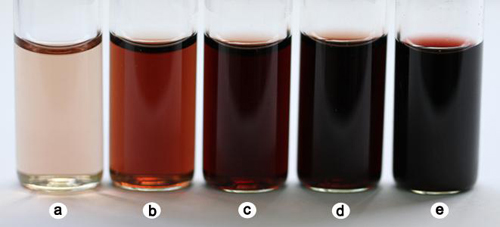
Figure 4. Color comparison of DPBQ in water at different concentrations (a-d: 100, 500, 1000 and 1500 μg/mL of DPBQ respectively) with L. canum nectar in deepest color (e).
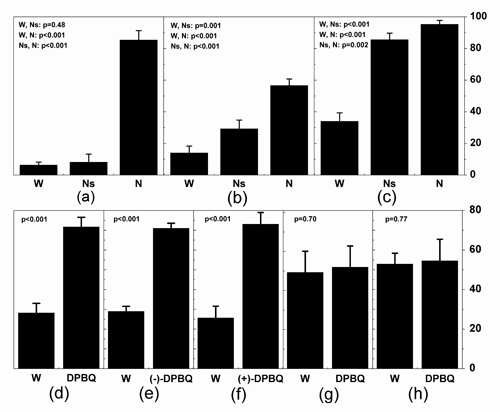
Figure 5. Preference and consumption of nectar (N), nectar sugar (Ns) DPBQ, (-)-DPBQ, (+)-DPBQ (each 500 μg/mL) and water (W) by the bird Z. japonicus. (a, d-f) Distribution of first choice; (b, g) Distribution of first choice (outside painted dark brown to match nectar); (c, h) Consumption per trial (outside painted to match color of nectar or DPBQ solutions).




